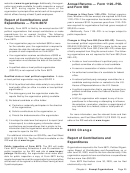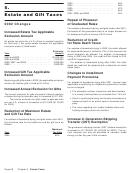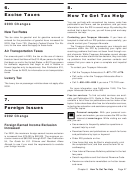Publication 553 - Highlights Of 2002 Tax Changes Page 5
ADVERTISEMENT
make contributions, without penalty, to a QTP even if
1) The allowance for room and board, as determined by
contributions are also being made to a Coverdell ESA on
the eligible educational institution, that was included
behalf of the same beneficiary. Before 2002, contributions
in the cost of attendance (for federal financial aid
to the Coverdell ESA that were made in the same year as
purposes) for a particular academic period and living
contributions to a QTP were subject to the additional tax on
arrangement of the student.
excess contributions.
2) The actual amount charged if the student is residing
Certain expenses of special needs students qualify.
in housing owned or operated by the eligible educa-
The definition of qualified higher education expenses has
tional institution.
been expanded to include expenses of a special needs
beneficiary that are necessary in connection with that
Age limits waived for special needs beneficiaries. You
person’s enrollment or attendance at an eligible institution.
can make contributions to a Coverdell ESA for a special
needs beneficiary after his or her 18th birthday. Also, you
Limit on room and board changed. The limit on the
can leave assets in a Coverdell ESA set up for a special
amount that is considered reasonable for room and board
needs beneficiary after he or she reaches age 30. Prior to
expenses has changed. The maximum allowance is the
2002, there were no special rules for these beneficiaries.
greater of the following two amounts.
Coverdell ESA coordinated with Hope and lifetime
1) The allowance for room and board, as determined by
learning credits. You may be able to claim a Hope or
the eligible educational institution, that was included
lifetime learning credit in the same year in which the bene-
in the cost of attendance (for federal financial aid
ficiary takes a tax-free withdrawal from a Coverdell ESA.
purposes) for a particular academic period and living
However, the beneficiary cannot use the expenses on
arrangement of the student.
which the credit is based to figure the taxable portion of the
withdrawal from the Coverdell ESA. Previously, in order to
2) The actual amount charged if the student is residing
claim an education credit, the designated beneficiary had
in housing owned or operated by the eligible educa-
to waive tax-free treatment of the withdrawal.
tional institution.
Coverdell ESA coordinated with QTP. If a designated
Distributions from state-sponsored QTPs may be tax
beneficiary takes withdrawals from both a Coverdell ESA
free. A distribution from a QTP established and main-
and a QTP in the same year, and the total withdrawn is
tained by a state (or an agency or instrumentality of the
greater than the beneficiary’s adjusted qualified higher
state) can be excluded from income if the amount distrib-
education expenses, those expenses must be allocated
uted is used to pay qualified higher education expenses.
between the withdrawal from the Coverdell ESA and the
withdrawal from the QTP before figuring how much of each
Qualified education expenses reduced by tax-free
withdrawal is taxable. Prior to 2002, the earnings portion of
benefits. Before the taxability of any distribution from a
QTP distributions was fully taxable.
QTP can be figured, the designated beneficiary must de-
Definition of family members expanded. For purposes
termine the amount of qualified education expenses that
of rollovers and changes of designated beneficiaries, the
has been covered by other tax-free educational benefits.
definition of family members is expanded to include first
Only the remaining expenses are used to figure what
cousins of the designated beneficiary.
portion of the distributed earnings is tax free. Tax-free
educational assistance includes:
•
Qualified Tuition Program (QTP)
Scholarships that are excluded from gross income,
•
Veterans’ educational assistance,
Beginning in 2002, the following changes apply to QTPs.
•
For more information, see chapter 6 in Publication 970,
Pell grants,
Tax Benefits for Education.
•
Employer-provided educational assistance, and
Name changed. Qualified state tuition programs
•
Any other nontaxable payments (other than gifts,
(QSTPs) have been renamed qualified tuition programs
bequests, or inheritances) received for education ex-
(QTPs).
penses.
QTPs can be established and maintained by educa-
tional institutions. Before 2002, only a state (or an
QTP coordinated with Hope and lifetime learning cred-
agency or instrumentality of a state) could establish and
its. You may be able to claim a Hope or lifetime learning
maintain a QTP. Now you can also make contributions to a
credit in the same year in which the beneficiary takes a
QTP established and maintained by one or more eligible
tax-free distribution from a QTP. However, the QTP benefi-
educational institutions (generally private colleges and uni-
ciary cannot use the expenses on which the credit is based
versities). Earnings distributed from privately-sponsored
to figure the nontaxable portion of the QTP distribution.
QTPs before 2004 are not eligible for tax-free treatment.
Any part of the QTP distribution that is taxable only
because an education credit was claimed is not subject to
Contributions to both a QTP and a Coverdell education
the 10% additional tax on taxable distributions.
savings account (ESA) allowed in same year. You can
Chapter 1 Tax Changes for Individuals
Page 5
ADVERTISEMENT
0 votes
Related Articles
Related forms
Related Categories
Parent category: Financial
 1
1 2
2 3
3 4
4 5
5 6
6 7
7 8
8 9
9 10
10 11
11 12
12 13
13 14
14 15
15 16
16 17
17 18
18 19
19 20
20 21
21 22
22 23
23 24
24 25
25 26
26 27
27 28
28 29
29 30
30 31
31








